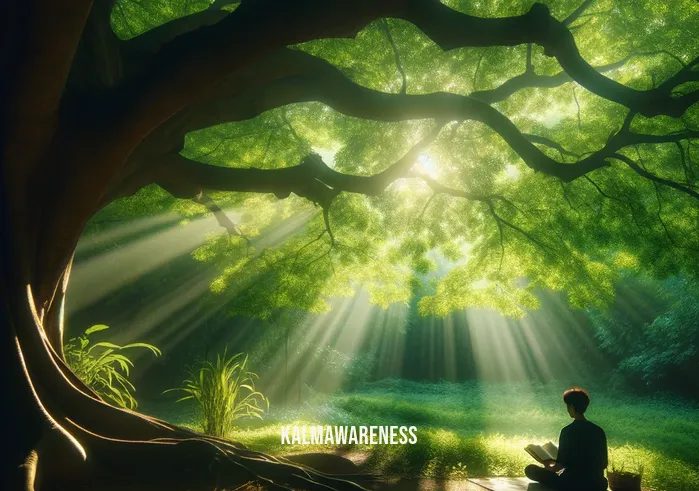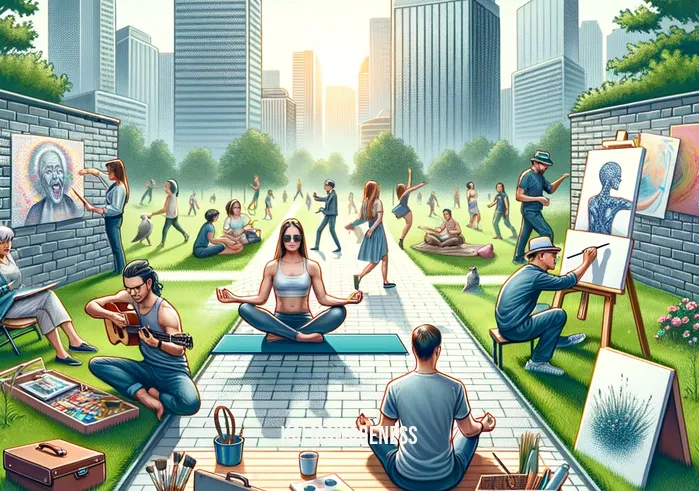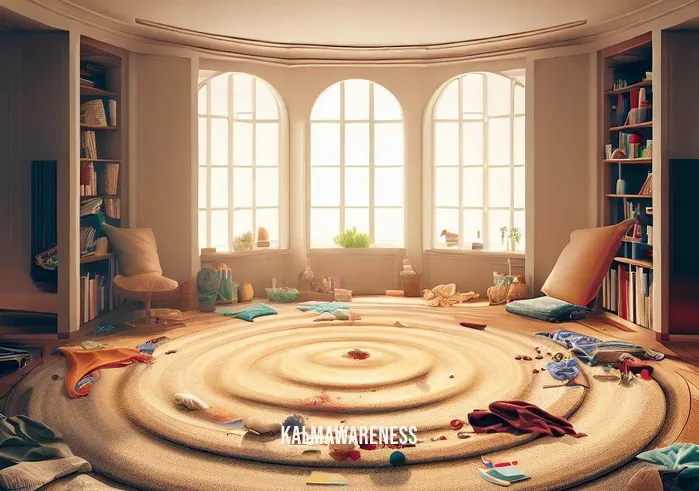The Art of Attention: The Pathway to True Mindfulness
In our bustling digital age, the pursuit of the art of attention stands as a cornerstone for inner peace and growth. It is through this art that one hones the ability to focus, develops concentration, practices mindful awareness, observes intricately, and delves into the mysteries of mind-wandering. The doorway to this art often opens through the realms of breathing and meditation, ancient practices that have stood the test of time.
Understanding the Essence of Focus
Focus is more than just the absence of distraction. It’s the conscious decision to direct our mental energies towards a singular point or subject. Much like the precision with which a lens captures light, our mind, when trained properly, can concentrate on the task or thought at hand, excluding all else. There’s a poignant understanding in fire meditation, where the continuous gaze at a flame signifies an unwavering attention to the present.
The Pillars of Concentration
Concentration isn’t achieved overnight. It requires consistent practice, much like a musician practicing a complex piece until perfection. And just as the saying goes, “If practice makes perfect, I’m practice’s baby”, indicating the essence of consistent effort in mastering concentration. Techniques such as the hug method shifting and being in sync with the best Hz for meditation provide a foundation to strengthen our concentration muscles.
The Beauty of Mindful Awareness
Mindful awareness is the gentle art of being present. It’s about acknowledging the symphony of our thoughts, feelings, and sensations without judgment. As one dives deeper into this awareness, methods such as touch that body part and reflecting on the notion that a thought is just a thought emerge as valuable tools. This awareness often intertwines with practices like a brief meditation on breath, a cornerstone to rooting oneself in the present.
Observing: The Silent Witness
Observing is about detachment. It’s the art of being an onlooker to the theater of our mind and the world around us. Bruce Lee’s approach to life, encapsulated in his philosophy of Bruce Lee meditation, touches upon this art where one doesn’t react but rather responds to life’s challenges. There’s a profound power in simply being, in letting the game come to you, rather than aggressively chasing it.
The Mystery of Mind-Wandering
Contrary to popular belief, mind-wandering isn’t always a negative trait. It’s a sign of a creative, restless mind. Through practices like flight rising meditate and techniques involving brain wave entrainment, one learns to harness this wandering energy. It’s akin to holding a bird; not too tight that it suffocates, and not too loose that it flies away. Mind-wandering, when channeled rightly, can be a source of innovation and creativity.
As we stand at the intersection of the digital age and the age-old wisdom of mindful practices, it becomes imperative to delve deeper into the art of attention. It’s a journey, a pathway, and as we proceed further, we’ll explore more intricate methods, philosophies, and stories that revolve around this art.
For those curious about the depth of meditation postures, their historical significance, and how it aids in cultivating attention, the insights of dhyani mudra and the serene aura of the meditating man await you in the next segment. Dive deeper, and let’s continue this exploration of the mind’s vast landscape. Continue reading to uncover the layers of attention and how one can truly occupy oneself with the present.

Harnessing the Subtleties of the Art of Attention
The journey into the realm of the art of attention delves deeper as we venture into its myriad facets. It is not just a philosophical construct but a transformative tool that aids in understanding oneself and the world at large. With our lives inundated with stimuli, honing this art becomes indispensable for mental clarity, personal growth, and spiritual upliftment.
Intricate Practices to Cultivate Attention
The Bairn Bowl Technique: By channeling the spirit of bairn bowl, one can cultivate a sense of focus reminiscent of a child’s unwavering attention. It’s the purity of attention we often observe in children, unburdened by the worries of the world.
Meditating on Words of Power: Words carry vibrations, and when we meditate upon them, they resonate within our being. Delving into the practice of meditating on words of power can create a symphony of focus and intentionality within us.
Aiming for the Moment: Not the past, not the future, but this very moment. The practice of aiming for the moment helps anchor our attention to the present, encapsulating the essence of mindful attention.
Understanding Attention Through Definitions
The act of focusing isn’t merely about keeping distractions at bay. It’s a multi-layered process, deeply interwoven with our psyche. By grasping its definitions, we can better appreciate its nuances. Here’s a handy table to provide a clearer perspective:
| Term | Definition | Techniques and Practices |
|---|---|---|
| Mindful Observation | Being present without judgment, observing thoughts without becoming entangled in them. | Bairn Bowl, Meditating on Words of Power |
| Concentrated Engagement | Deeply immersing oneself in a task, letting go of external distractions. | Aiming for the Moment, Bairn Bowl |
| Reflective Introspection | Looking within to understand thought patterns and emotional responses. | Keeping in Mind Definition |
| Attentive Responsiveness | Reacting to situations with a balanced mind, rooted in the present. | Let the Game Come to You |
| Controlled Mind-Wandering | Allowing the mind to wander but within a framework, harnessing creativity without getting lost. | I Only Have One Thing on My Mind |
The Path Ahead
Attention is akin to a muscle. The more we train it, the stronger it becomes. Whether through age-old practices or innovative techniques, the art of attention beckons us to explore its depth, promising tranquility and clarity in return.
Yet, as with any art form, there is always more to explore and understand. As we journey onward, the next chapter delves into the challenges and barriers that often obstruct our path in mastering attention. We’ll also uncover strategies to overcome these barriers and truly immerse ourselves in the present moment.
So, whether you’re an ardent practitioner or a curious novice, brace yourself as we navigate the intricate tapestry of the art of attention in the coming chapters. Continue reading to unravel the secrets that have been cherished and practiced by mindfulness enthusiasts across ages.

Drawing Hope from the Art of Attention
The exploration of the art of attention is, at its core, a journey into the heart of hope and inspiration. In our dynamic world, attention provides a sanctuary—a place of stillness and focus. While understanding its mechanics and practicing techniques are essential, the true essence of this art emerges when we find hope and draw inspiration from it.
Quotes That Illuminate the Path
Throughout history, thought leaders and spiritual guides have echoed the significance of attention. Their words serve as beacons, shedding light on our journey.
“The greatest gift you can give someone is your attention.” – Jim Rohn
- This quote emphasizes the essence of focused x minds, underlining the idea that true attention is the epitome of care and connection.
“Attention is the rarest and purest form of generosity.” – Simone Weil
- Weil’s words resonate with the teachings of the dhyani mudra, a symbol of contemplation and absorption.
“The moment one gives close attention to anything, even a blade of grass, it becomes a mysterious, awesome, indescribably magnificent world in itself.” – Henry Miller
- This quote captures the spirit of occupying oneself with the present, a mantra for those dedicated to the art of attention.
Inspiring Real-Life Narratives
The Story of Sarah: A journalist by profession, Sarah found herself overwhelmed by the constant barrage of news, stories, and deadlines. In her search for balance, she stumbled upon the practice of meditating man. By allocating just fifteen minutes daily to this practice, Sarah rejuvenated her ability to pay attention. Not only did her professional work improve, but her relationships also flourished, a testament to the transformative power of focused attention.
Leon’s Turnaround: Leon, a schoolteacher, often found himself lost amid the cacophony of his classroom. Yet, a simple practice changed everything. By employing techniques from bruce lee meditation, Leon transformed his classroom into a hub of mindfulness. He reported improved student engagement, better classroom dynamics, and most importantly, he rediscovered his passion for teaching.
A Hopeful Horizon
Attention isn’t merely a cognitive skill; it’s a source of inspiration, a gateway to hope. In these tales and quotes, one discerns a common theme: by honing attention, we discover a world of magnificence, right in front of us.
Yet, while the art of attention brings inspiration, it’s also essential to understand its obstacles. As we journey forward, our next chapter will delve into the challenges that might deter us from mastering this art and strategies to navigate them. For those seeking a comprehensive understanding of attention’s ebbs and flows, a deeper exploration awaits in the subsequent pages. Continue reading, and let’s together traverse this enriching landscape of the art of attention.
@
Dissecting the Intricacies of the Art of Attention
Attention, in all its splendor, is a multifaceted gem. To truly embrace the art of attention, it’s essential to delve into its nuances, complexities, and intricacies. While we’ve touched upon its significance and inspirational potential, this chapter aims to break it down further, shedding light on its diverse dimensions.
Components of Attention
Attention isn’t just a monolithic entity but consists of several interconnected components:
Selective Attention:
- Definition: The ability to focus on a specific stimulus while ignoring others.
- Example: Concentrating on a meditating man amidst a bustling street.
Sustained Attention:
- Definition: Maintaining focus over prolonged periods.
- Example: Engaging in a long bruce lee meditation session without getting distracted.
Divided Attention:
- Definition: Simultaneously attending to multiple tasks.
- Example: Balancing the act of occupying oneself with multiple activities without compromising on quality.
Alternating Attention:
- Definition: Shifting focus between tasks demanding different cognitive skills.
- Example: Transitioning from focused x minds meditation to a rigorous mental activity.
Factors Influencing Attention
The depth and quality of our attention can be influenced by various factors:
Internal Factors:
- Mental State: Your current psychological condition, like stress or relaxation.
- Physical Health: Fatigue, illness, or general well-being can impact attention span.
- Interest: Topics or tasks that resonate with personal interests naturally garner more attention.
External Factors:
- Environment: A calm setting like that in dhyani mudra practices enhances focus.
- Distractions: External stimuli, be it noise, visuals, or other disruptions.
- Task Complexity: Simpler tasks might require less attention than complex ones.
Strategies to Enhance the Art of Attention
Fortifying attention isn’t merely about understanding its components but also about adopting strategies:
- Mindfulness Techniques: Grounding exercises, such as meditating on words of power, can anchor the mind.
- Regular Breaks: Ensures sustained attention doesn’t lead to mental fatigue.
- Prioritization: Focusing on tasks sequentially rather than multitasking.
Paving the Way Forward
While we’ve dissected attention, understanding its essence is just the beginning. The real journey is in the application. As we pave our way forward, the culmination of our exploration awaits in the next chapter, tying together all that we’ve unraveled about the art of attention.
Continue reading, for a conclusion that aims not to merely summarize but to inspire, urging you to incorporate these insights into your daily life.
@
Reflecting on Our Journey Through the Art of Attention
As we find ourselves at the culmination of our exploration into the art of attention, it’s a moment to pause, reflect, and appreciate the myriad facets of this transformative practice. Attention, in its essence, isn’t just a cognitive skill—it’s an art form, a dance between the mind and the world around us.
Journey Recap: The Pillars of Attention
From the whispers of ancient wisdom to the discoveries of modern science, the art of attention spans diverse landscapes:
- We began by understanding the essence of focus and concentration, reminiscing about techniques like the bairn bowl method.
- Venturing deeper, we encountered inspirational tales and quotes that imbued hope, offering us perspective from luminaries of different eras.
- Our exploration further led us to dissect attention’s intricacies, unearthing its components, influencers, and enhancement strategies.
Applying Our Insights
While understanding is the foundation, application breathes life into knowledge:
- In our personal lives, techniques like focused x minds meditation can be incorporated for daily mindfulness.
- In professional arenas, strategies learned from occupying oneself can enhance productivity and creativity.
- For those on a spiritual quest, the teachings of dhyani mudra beckon for a deeper dive into self-awareness.
A Heartfelt Thank You
To our cherished readers, thank you for accompanying us on this enlightening journey. Your time, attention, and curiosity have been the driving force behind this exploration.
While our expedition into the art of attention concludes here, remember, every end is a new beginning. We invite you to delve deeper, explore more articles, and immerse yourself further into the ocean of knowledge our magazine offers. If certain concepts intrigued you, revisit previous sections, clarify doubts, and solidify your understanding.
Until Next Time…
As we part ways on this topic, keep in mind that the journey of learning is perpetual. We assure you of more insightful content in our upcoming editions. And until then, may you harness the power of the art of attention in every moment, every breath, and every heartbeat.
Stay curious, and don’t forget to explore more on meditating on words of power and other insightful topics. Here’s to many more enlightening journeys together!




